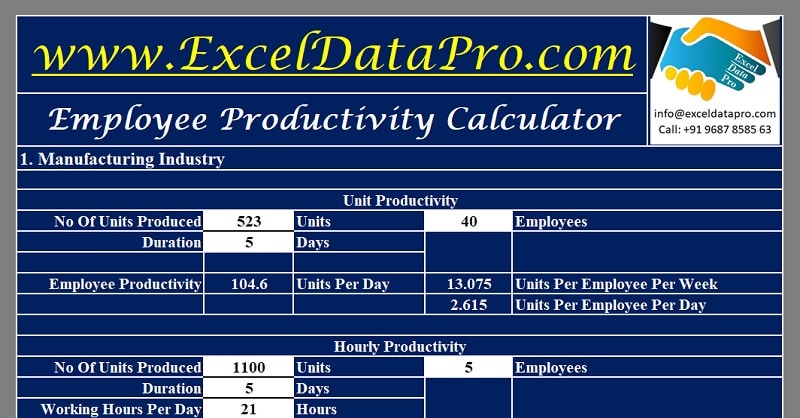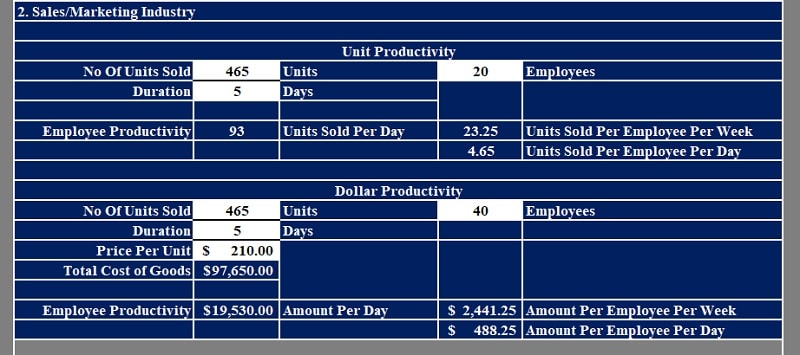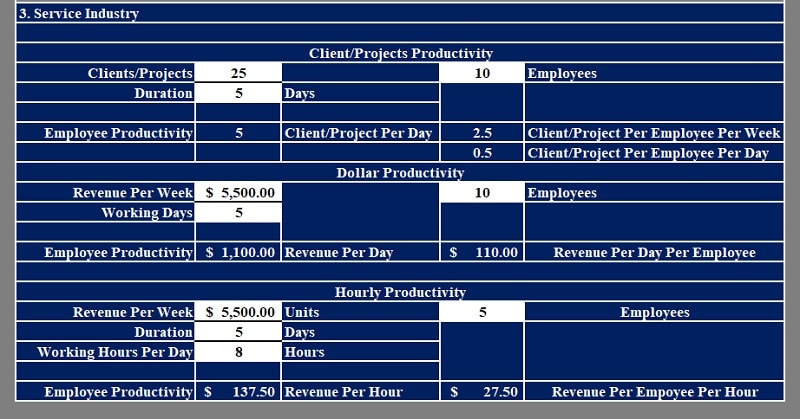
Use this Online Employee Productivity Calculator to get the desired metric in just a few clicks or download a free template in Excel.
| Employee Productivity Calculator | |
|---|---|
| Unit Productivity | |
| Total Number of Units | |
| Total Duration | |
| No. of Employees | |
| Unit Productivity : | Units Per Employee |
| Dollar Productivity | |
| Total Cost of Goods | |
| Total Duration | |
| No. of Employees | |
| Dollar Productivity : | |
| Hourly Productivity | |
| Total Number of Units | |
| Total Duration | |
| Working Hours per Day | |
| Hourly Productivity : | |
Employee Productivity Calculator is an excel template that helps you calculate employee productivity for manufacturing, sales/marketing, and service industries.
Therefore, just enter the required data and you can calculate the productivity in terms of units, dollars, hours, etc.
Table of Contents
What is Employee Productivity?
Employee Productivity is the production/revenue received during a specific period against the number of employees or resources consumed in that specific period. Productivity is measured differently depending on the industry.
Thus, in the manufacturing Industry, employee productivity can be measured in terms of units produced per period, units produced per employee, the worth of goods in dollars per period, the worth of goods in dollars.
Moreover, for the Sales/Marketing Industry, it is measured in terms of sale of units per employee per day, sales in dollar per employee per day.
Whereas, in the Service industry, employee productivity is measured in terms of clients/projects handled per employee, the number of projects completed per employee or per hour, etc.
Formula to Calculate Employee Productivity

The basic formula for calculating employee productivity is the output divided the input during a particular time.
Types of Employee Productivity
There are 3 types of employee productivity: Unit Productivity, Dollar Productivity, and Hourly Productivity.
You can obtain employee productivity by dividing the average output per period by the total inputs consumed during that period. The input includes capital costs, energy costs, material costs, and manpower.
Furthermore, while we measure sales productivity, we will have to add a variety of additional outputs, like the number of new customers, the number of positive leads generated, and the volume of sales in dollars.
Moreover, in the service industry, as intangible outputs are involved you will be able to measure the number of customers served or the number of tasks completed.
Whereas, in the manufacturing industry, you will either measure the production per employee or worth of goods one employee can produce during that specific time.
Besides, productivity in the service industry changes depending on the industry. It all depends upon the purpose and industry for which you measure productivity.
Thus, as shown in the example below, turning the company into a sales company gives the revenue per salesperson, and the same in manufacturing shows the units per employee or worth of unit produced per employee.
Let us understand with a simple example.
Example
Company A has is a manufacturing unit and produces 523 units in a week utilizing 15 employees. So applying the formula output/input we get 523/15 = 34.86 units per employee per week.
Moreover, it can also be measured in terms of hours. Let us assume that the value of 523 units is $50,000 and the unit is working averagely 21 hours a day.
Thus, to calculate the productivity you need to multiply 21 hours to 5 days a week which is 105 hours total. Thus, 523/105 = 4.98 units per hour or 50000/105 = $ 476.19 per hour.
Additionally, when we turn Company A into a Sales Agency, if Company A generated sales of $ 110,000 in a week utilizing 20 salespeople.
Hence, output/input = 110000/20 = $ 5,500 Sales revenue per salesperson per week. Per day sales will be calculated by $ 5,500/5 working days = $ 1,100 per person per day.
Employee Productivity Calculator Template (Excel, Google Sheets, and OpenOffice)
To simplify the process, we have created a simple Employee Productivity Calculator Excel Template for the manufacturing, sales/marketing, and the service industry.
In this template, you need to enter the required data and it will perform the calculations automatically according to the given formula.
Excel Google Sheets Open Office Calc
Click here to Download All HR Metrics Excel Templates for ₹299.
Additionally, you can download other useful HR Metrics Templates like Human Capital ROI Calculator, EBIT Per FTE Calculator, Turnover Cost Calculator, Yield Rate Calculator, and many more from our website.
Let us understand how to use this Calculator in detail.
Contents of Employee Productivity Calculator
This template consists of 3 major sections: Manufacturing Industry, Sales/Marketing Industry, and Service Industry.
Each of the above sections is further divided into subsections.
Manufacturing Industry
In Manufacturing Industry, employee productivity is measured in terms of units, dollars, and hours.

Units Productivity
For Unit Productivity, you need to enter 3 details; No of Units Produced, Duration of Production, and Number of employees.
When you enter these 3 details it will calculate the following Employee productivity for you:
- Units Per Day
Formula: Total Number of Units/Total Duration - Units Per Employee Per Week
Formula: Total Number of Units / Number of Employees - Units Per Employee Per Day
Formula: Units Per Day / Number for Employees
Hourly Productivity
For Hourly Productivity, you need to enter 4 details; No of Units Produced, Duration of Production, Number of employees, and working hours per day.
When you enter these 4 details it will calculate the following Employee productivity for you:
- Units Per Hour
Formula: (Total Number of Units/Total Duration) / Working Hours Per Day - Units Per Employee Per Hour
Formula: Units per Hour / Number of Employees
Dollar Productivity
For Dollar Productivity, you need to enter 4 details; No of Units Produced, Duration of Production, Price Per Unit, and Number of employees.
When you enter these 4 details it will calculate the Total Cost of goods as well as the following Employee productivity for you:
- Worth of Goods Produced Per Day
Formula: Total Cost of Goods/Total Duration - Worth of Goods Produced Per Employee Per Week
Formula: Total Cost of Goods / Number of Employees - Worth of Goods Produced Per Employee Per Day
Formula: Worth of Goods Produced Per Day / Number of Employees
Sales/Marketing Industry
In the Sales/Marketing Industry, employee productivity is measured in terms of units and dollars.

Unit Productivity
For Unit Productivity, you need to enter 3 details; No of Units Sold, Duration, and Number of employees.
When you enter these 3 details it will calculate the following Employee productivity for you:
- Units Sold Per Day
Formula: Total Number of Units Sold / Total Duration - Units Sold Per Employee Per Week
Formula: Total Number of Units Sold / Number of Employees - Units Sold Per Employee Per Day
Formula: Units Sold Per Day / Number for Employees
Dollar Productivity
For Dollar Productivity, you need to enter 4 details; No of Units Sold, Duration, Price Per Unit, and Number of employees.
Moreover, when you enter these 4 details it will calculate the Total Cost of goods as well as the following Employee productivity for you:
- The worth of Goods Sold Per Day
Formula: Total Cost of Goods/Total Duration - Worth of Goods Sold Per Employee Per Week
Formula: Total Cost of Goods Sold / Number of Employees - Worth of Goods Sold Per Employee Per Day
Formula: Worth of Goods Sold Per Day / Number of Employees
Service Industry
In the service industry, employee productivity is calculated in terms of clients or projects, dollars, and hours.

Client/Projects Productivity
For Client/Project Productivity, you need to enter 3 details: Number of Clients/Projects Completed, Duration, and Number of employees.
By entering these 3 details it will calculate the following Employee productivity for you:
- Clients/Projects Per Day
Formula: Number of Clients/Total Duration - Clients/Projects Per Employee Per Week
Formula: Total Number of Clients/Projects / Number of Employees - Clients/Projects Per Employee Per Day
Formula: Clients/Projects Per Day / Number for Employees
Dollars Productivity
For Dollar Productivity, you need to enter 3 details; Revenue Per Week/Month, Duration, Price Per Unit, and Number of employees.
Thus, by entering these 3 details it will calculate the following Employee productivity for you:
- Revenue Per Day
Formula: Revenue Per Week / Total Duration - Revenue Per Employee Per Day
Formula: Revenue Per Day / Number of Employees
Hourly Productivity
For Hourly Productivity, you need to enter 4 details; Revenue Per Week, Duration, Number of employees, and working hours per day.
Thus, when you enter these 4 details it will calculate the following Employee productivity for you:
- Revenue Per Hour
Formula: (Revenue Per Week / Total Duration) / Working Hours Per Day - Revenue Per Employee Per Hour
Formula: Revenue Per Hour / Number of Employees
Moreover, this template can be helpful to manufacturing units, sales managers, freelancers, service providers, etc.
Importance of Measuring Employee Productivity
There are many benefits when it comes to measuring employee productivity. Thus, here are a few that will convince you to focus on this aspect of employee management.
- Proper usage of the workforce that maximizes the production helps to lower operational costs.
- A decrease in operational costs eventually leads to increased profits.
- Measuring employee productivity helps the management to better human resource management.
- It helps in the timely supply of goods or services to your customers and in turn, it increases customer satisfaction.
- Increased profitability opens the doors for growth opportunities.
- A well-managed production helps the business to beat their competitors.
Hence, measuring employee productivity must be an important part of any business.
Additionally, as an employee is an investment, the Human Capital ROI must exceed the employee cost. Therefore, the growth of an organization lies in the difference between an employee’s productivity and employee cost.
Ways to Improve Employee Productivity
Employee productivity has a huge impact on profits. With a simple equation, you can track productivity per individual, team, or even department. Here are some simple steps you can take to improve employee productivity.
- Knowing the skill sets of your employee and matching tasks to their skill.
- Effectively Communication.
- Create Incentive Programs.
- Encourage Flexible Working Hours.
- Use the data of your employees to identify the need for proper structuring of the workforce.
- Focus on quality rather than quantity. It applies to service industries and also to the manufacturing industry.
- Provide opportunities for your employees to develop their skills by providing them with proper training.
We thank our readers for liking, sharing, and following us on different social media platforms.
If you have any queries or suggestions please share in the comment section below. I will be more than happy to assist you.
Frequently Asked Questions
What are the 3 crucial things that affect Employee Productivity?
Employee Engagement, Workplace Environment, and Technology are the three crucial things that affect employee productivity.
What is the effect of low productivity?
Lower productivity has a big impact on employee morale. Moreover, it also hinders efficiency. Eventually, the profit margins of the company are also affected.
Unfortunately, lower productivity is the result of internal issues like poor management, unavailability of proper tools and equipment, etc.
What is the 70 percent rule for productivity?
The 70 percent rule is a time management principle that suggests that employees should withhold at least 70% of their time productive out of total working hours. This markup is the best performance. To effectively do this you need to prioritize your tasks.